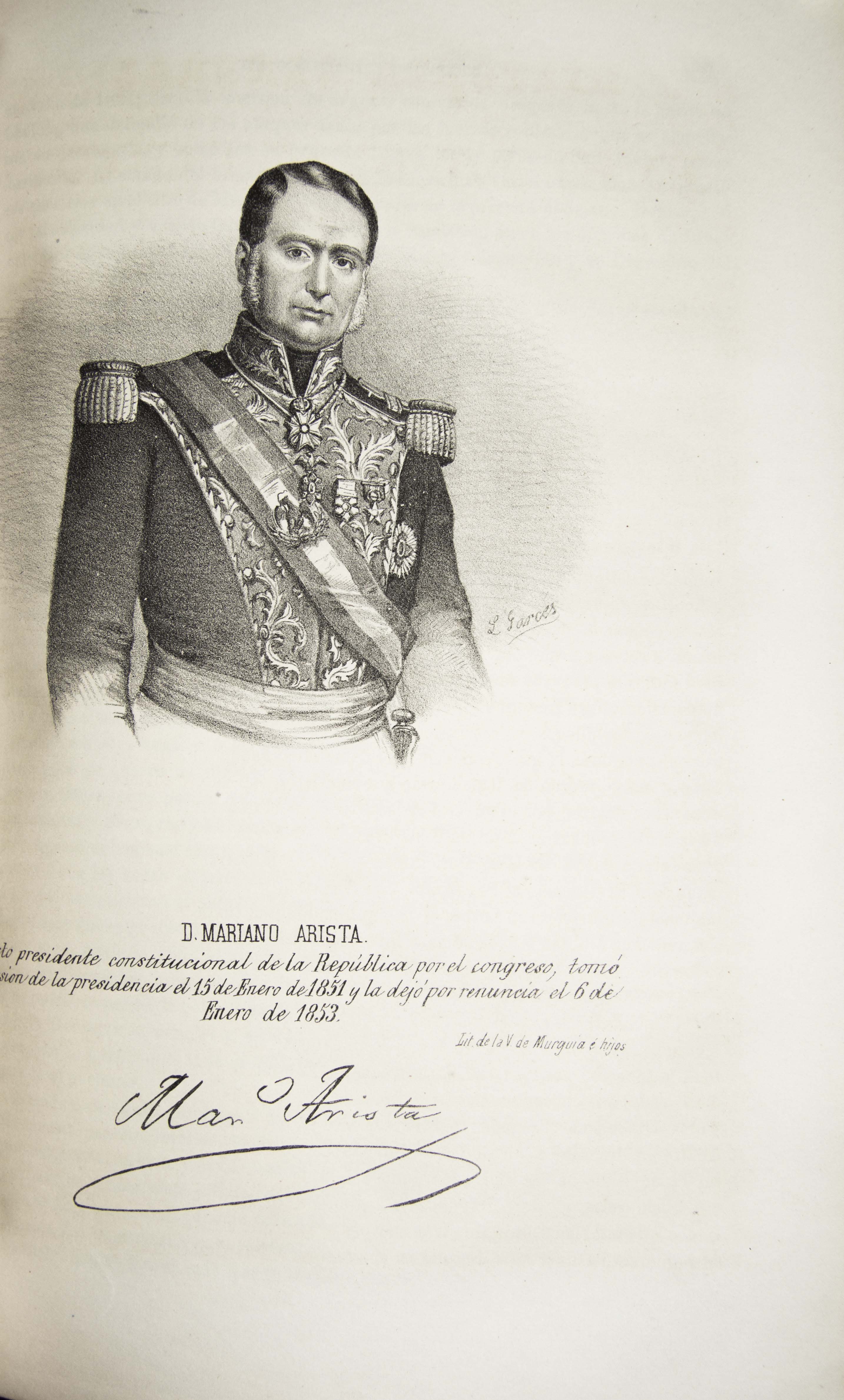Mariano Arista
July 26, 1802—August 7, 1855
José Mariano Martín Buenaventura Ignacio Nepomuceno García de Arista Nuez, a career army officer and one of Mexico's early presidents, was born in San Luis Potosi on July 26, 1802. Arista began his military career at age eleven as a cadet in the Spanish army. In 1821, during the Mexican War for Independence and shortly after advancing to the rank of lieutenant, he joined the revolutionary forces of Agustin de Iturbide. In 1824 he was promoted to lieutenant colonel after helping to overthrow Iturbide.
During the first three decades of Mexico's existence as an independent nation, Arista advanced in rank from Colonel to General, actively participating in the revolutions and counter-revolutions that mark this era as one of the most politically unstable in Mexico's history. In 1833 he went into exile in the United States, where he learned how to speak English while reportedly working in the tin business in Cincinnati, Ohio.
After returning to Mexico in 1836, Arista was restored to his former rank and in 1839 led forces that successfully squelched an attempt by rebels to establish an independent "Republic of the Rio Grande." Until captured by the Prince de Joinville, he also helped defend Vera Cruz against the French in 1842.
In early 1846, shortly after the United States annexed Texas, President James K. Polk sent troops commanded by Gen. Zachary Taylor to occupy the disputed territory that lay between the Rio Nueces and the Rio Grande. In response, Mexican President Mariano Paredes placed Arista in charge of Mexico's Army of the North and ordered him to drive the US troops from soil claimed by Mexico.
On April 24, 1846 Arista arrived at Matamoros, where after taking command of Mexican forces from Gen. Pedro Ampudia, he ordered troops to cross the Rio Grande and isolate Fort Texas, which Taylor had built upon arrival on the Rio Grande, from the US supply depot at Point Isabel. In the meantime, Taylor sent out two patrols. One was commanded by Capt. Seth Thornton.
The following day, on the north bank of the Rio Grande, Mexican troops ambushed Thornton's dragoons, killing fourteen Americans and capturing the remainder. On May 13, after Taylor's report of this incident reached Washington, Congress declared war, despite the fact that the incident had occurred on disputed ground.
Meanwhile, thinking Point Isabel might be attacked by Arista's troops, Taylor left a small force under Maj. Jacob Brown at Fort Texas while he and the greater part of his army marched north. They reached Point Isabel on May 2.
The following day, as Taylor had feared, artillery under command of General Mejía in Matamoros commenced a bombardment of Fort Texas. Concurrently, Arista led 4,000 Mexican soldiers toward the coast. His objective was to lure Taylor, who was certain to come to the aid of the besieged fortress, into battle.
On May 7, as Arista had hoped, Taylor's men began marching back to the Rio Grande. The following day, on the prairie at Palo Alto, a point mid-way between Point Isabel and Matamoros, the Americans halted when they saw the Mexican army blocking the southbound road. After Taylor's troops had filled their canteens from a nearby pond, he ordered them to advance.
The ensuing Battle of Palo Alto was principally an artillery duel. When Arista ordered his cannons to open fire on the advancing Americans, Taylor halted and three batteries of "flying artillery" positioned themselves in the center of the road and on either side. The American cannons were so effective that future president Ulysses S. Grant's regiment had little to do but stand "at order arms as spectators, watching the effect of our shots upon the enemy."
As the battle raged, the prairie grass caught fire, enveloping both armies in obscuring smoke. Hoping to take advantage of it, the Mexican troops moved right while simultaneously, the American artillery moved left and then fired through the smoke, blasting gaps in the Mexican lines. The battle ended at sunset, with no clear victor, although Arista's losses greatly exceeded those of Taylor.
That night, while the Americans camped at Palo Alto, Arista and his men fell back to a thickly wooded area near the Resaca de la Palma, a long narrow lake near the Rio Grande. On May 9 the two armies clashed again. This time infantry, cavalry, and artillery, were all participants. In the end, the Mexican troops broke and ran to the Rio Grande, where in their haste to escape, many were drowned. A few days later, after Arista abandoned Matamoros, Taylor's army crossed the Rio Grande and occupied the city.
Following his defeat at Palo Alto and Resaca de la Palma, Arista was relieved of command and recalled to Mexico City, where he sat out the remainder of the war.
In 1848 Arista was appointed secretary of war by President Herrera and in 1851, he succeeded Herrera as president. In doing so, he became the first chief executive in Mexico's history to be elected and then to take office without violence. Pursuing the reform policies of his predecessor, Arista resigned two years later, ostensibly to prevent a civil war. After Santa Anna returned to power, he went to Europe, where he died on August 7, 1855, aboard the steamer Tagus, en route from Cadiz to Southampton. He is buried in the Panteon Civil de Dolores cemetery in Mexico City.
For further reading:
Bancroft, Hubert Howe. The Works of Hubert Howe Bancroft, Volume XXII: The History of Mexico, Volume V, 1824-1861 (San Francisco: A. L. Bancroft & Company, 1885).
Grant, Ulysses S. Personal Memoirs of U.S. Grant (New York: Charles L. Webster & Company, 1894).
Noll, Arthur Howard. A Short History of Mexico (Chicago: A. C. McClurg and Company, 1890).
Robinson, Fayette. Mexico and Her Military Chieftains (Philadelphia: E. H. Butler & Co., 1847).
Segundo, Tomo. Los Gobernantes de Mexico (Mexico: J. M. Agular Ortiz, 1873).

